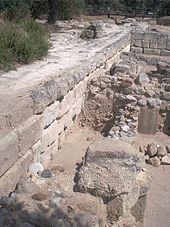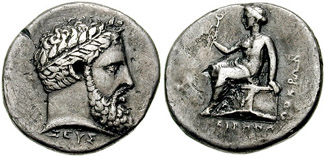Locri
| Locri | ||
|---|---|---|

|
|
|
| Country | Italy | |
| region | Calabria | |
| Metropolitan city | Reggio Calabria (RC) | |
| Coordinates | 38 ° 14 ' N , 16 ° 16' E | |
| surface | 25 km² | |
| Residents | 12,269 (Dec. 31, 2019) | |
| Population density | 491 inhabitants / km² | |
| Factions | Moschetta, San Fili, Baldari | |
| Post Code | 89044 | |
| prefix | 0964 | |
| ISTAT number | 080043 | |
| Popular name | Locresi | |
| Patron saint | Santa Caterina | |
| Website | Locri | |
Locri is an Italian municipality in the metropolitan city of Reggio Calabria on the south-east coast of Calabria with 12,269 inhabitants (as of December 31, 2019). It is the seat of the Roman Catholic diocese of Locri-Gerace and the successor city of the ancient Lokroi Epizephyrioi .
The ancient city
history
Four kilometers southwest of Locris is the ancient Lokroi Epizephyrioi ( Greek Λοκροί Ἐπιζεφύριοι, also Λοκρίς, Lokris or Latin Locri Epizephyrii , "the western Lokroi"). The city was founded in 680 BC. Chr. On the coast of the Ionian Sea from Locrian settlers , probably from the city ostlokrischen Opos , with the support of Sparta and the westlokrischen Ozolae founded. Strabon suspects that the ozolae were the main founders. In the 7th century BC The place received its laws through Zaleukos , after a century it was provided with a city wall made of large blocks.
In the first two centuries Lokroi was an ally of Sparta, from the 5th century BC onwards. An ally of Syracuse . In the first half of the 4th century BC In BC Lokroi became one of the most important cities in Magna Graecia . Lokroi is the home of the philosopher Timaeus .
Two colonies were founded by Lokroi, Hipponium and Medma . In Hellenistic times the city was allied with Rome . It was not until the Saracen invasions at the beginning of the 10th century AD that the city fell.
Remains of the city wall have been preserved, as well as of several temples and the theater outside the city , as well as - also outside the city - necropolis of the Siculians , Greeks and Romans, some of which are larger in size. In 1959 the financial archive of the Temple of Zeus was found during excavations.
The pinakes called "Locrian reliefs" also come from Lokroi . They are small, square, painted reliefs made of clay that were deposited in a shrine as gifts . Their origins and production are traced back to the late 6th and early 5th centuries BC. Dated. The boards had two holes through which they could be hung from a tree with a string. However, they were not found at the place of their consecration, but rather collected in a heap of rubble, to which they were brought after a certain time (as they were no longer needed directly, but as consecrated objects could not be removed from the sanctuary). Architectural remains of any associated temple were not found, which further complicates the interpretation. This must therefore be based on the pictorial representations on the panels, which cannot be clearly interpreted or assigned to the cult of a single deity. Many of the reliefs can possibly be associated with the myth about Persephone or with the goddess Aphrodite . Particularly in Italian research, the position is taken that the consecrations of the Locrian clay reliefs are related to so-called rites of passage and primarily relate to marriage and the associated transition from girl to woman. The excavation site of the so-called 100 chambers probably housed Lokroi's clay workshops. Most of the pinakes found are exhibited in the Museo Nazionale della Magna Grecia in Reggio Calabria , another collection is in the Antiquities Museum of Heidelberg University .
In the first half of the 5th century BC A local hero cult developed around the Locrian Olympic champion Euthymos , who was also worshiped as a river god . Votive tablets were also offered in the sanctuary of Euthymus.
The Ionian Temple

In the first half of the 5th century BC The inhabitants of Lokrois renewed their archaic Zeus temple in the Ionian style . The architects probably came from friendly Syracuse, because they repeated on around 470 BC. Chr. Built temples solutions that are already at a temple in Syracuse under the tyrant Hieron were used.
The new temple was in the same place as the old one, but had a slightly different orientation. It was 45.5 meters long and 19.8 meters wide. It had six Ionic columns on the front and back and 17 columns on the long sides. The column height was about 12 meters. Two pillars stood between the ante of the pronaos . The entablature formed the three-fascia architrave , frieze and tooth cut . The cella was divided into two aisles by a central column position. Inside the cella there was a limestone bothros , a large hole set in the ground, which served ritual acts. The temple was destroyed in the 11th century.
Due to the Saracen invasions, which took place from the middle of the 9th century, the inhabitants of Lokroi were forced to give up the city and take refuge in the protection of the mountains, after Gerace, which at that time was still a Basilian monastery . Some columns of the Ionic Temple of Zeus were integrated into the Norman-Romanesque cathedral, which was erected there and consecrated in 1084. The old Lokroi, however, fell into disrepair.
It was not until the beginning of the 20th century that the Italian archaeologist Paolo Orsi set about uncovering the remains of the Temple of Zeus after the Italian government refused Friedrich von Duhn 's permission to excavate. Today you can see the foundations of the two temples as well as an Ionic column stump. Many finds are housed in the nearby collection, some in the Museum of Reggio Calabria.
The theater
That in the 4th century BC The theater that was built in BC is located not far from the ancient Locri in what is now the Contrada Pirettina. The surrounding hills were used for the construction by cutting the cavea partially into the rock to avoid backfilling. The theater offered space for more than 4,500 visitors. Today only the central area can be visited.
Others
Locri is the seat of the private radio broadcaster Radio Studio 54 Network , which mainly broadcasts music.
sons and daughters of the town
- Doris , wife of the tyrant Dionysius I of Syracuse
- Philistion of Lokroi , famous Greek physician at the time of Plato
- Giuseppe Sculli (* 1981), football player
literature
- Emilio Barillaro: Locri e la locride. Editrice "Nossis", Reggio Calabria 1970.
- Felice Costabile: Municipium Locrensium. Istituzioni ed organizzazioni sociale di Locri romana. (Attraverso il corpus delle iscrizioni latine di Locri). Conte, Naples 1976.
Web links
Individual evidence
- ↑ Statistiche demografiche ISTAT. Monthly population statistics of the Istituto Nazionale di Statistica , as of December 31 of 2019.
- ↑ See for example Elisa Marroni, Mario Torelli : L 'obolo di Persefone. Immaginario e ritualità dei pinakes di Locri. Edizioni ETS, Pisa 2016, ISBN 978-88-467-4419-7 .
- ^ Nicolas Zenzen: 1896–1906: Antique originals and their buyers. In the S. (Ed.): Objects tell stories. 150 years of the Institute for Classical Archeology. Institute for Classical Archeology, Heidelberg 2016, ISBN 978-3-00-054315-9 , pp. 167–175, here p. 171.
- ^ Rabun M. Taylor: River Raptures. Containment and Control of Water in Greek and Roman Constructions of Identity. In: Cynthia Kosso, Anne Scott (Ed.): The Nature and Function of Water, Baths, Bathing, and Hygiene from Antiquity Through the Renaissance (= Technology and Change in History. Volume 11). Brill, Leiden / Boston 2009, ISBN 978-9-0041-7357-6 , p. 28.




